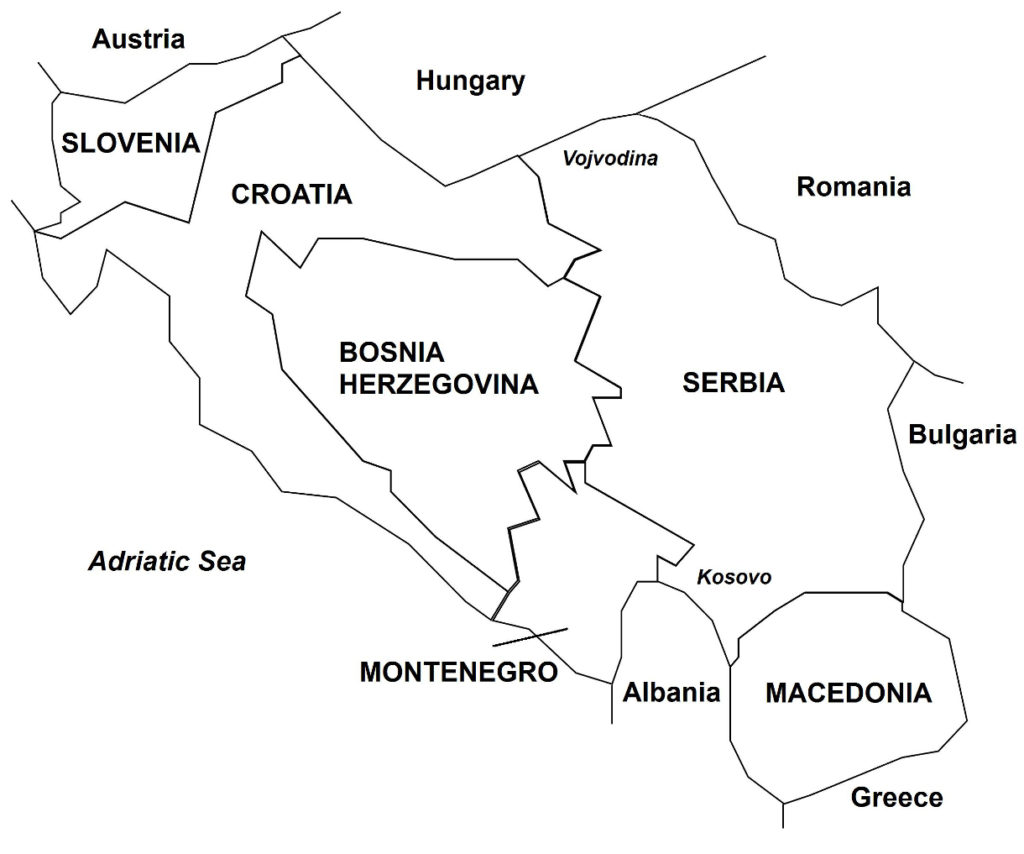Bosnian Serbs formed a majority in Bosnia’s northern regions. On January 5, 1992, Bosnian Serbs seceded from Bosnia-Herzegovina and established their own country. Bosnian Croats, who also comprised a sizable minority, had earlier (on November 18, 1991) seceded from Bosnia-Herzegovina by declaring their own independence. Bosnia-Herzegovina, therefore, fragmented into three republics, formed along ethnic lines.
Furthermore, in March 1991, Serbia and Croatia, two Yugoslav constituent republics located on either side of Bosnia-Herzegovina, secretly agreed to annex portions of Bosnia-Herzegovina that contained a majority population of ethnic Serbians and ethnic Croatians. This agreement, later re-affirmed by Serbians and Croatians in a second meeting in May 1992, was intended to avoid armed conflict between them. By this time, heightened tensions among the three ethnic groups were leading to open hostilities.
Mediators from Britain and Portugal made a final attempt to avert war, eventually succeeding in convincing Bosniaks, Bosnian Serbs, and Bosnian Croats to agree to share political power in a decentralized government. Just ten days later, however, the Bosnian government reversed its decision and rejected the agreement after taking issue with some of its provisions.

(Taken from Bosnian War – Wars of the 20th Century – Volume 1)
Background Bosnia-Herzegovina has three main ethnic groups: Bosniaks (Bosnian Muslims), comprising 44% of the population, Bosnian Serbs, with 32%, and Bosnian Croats, with 17%. Slovenia and Croatia declared their independences in June 1991. On October 15, 1991, the Bosnian parliament declared the independence of Bosnia-Herzegovina, with Bosnian Serb delegates boycotting the session in protest. Then acting on a request from both the Bosnian parliament and the Bosnian Serb leadership, a European Economic Community arbitration commission gave its opinion, on January 11, 1992, that Bosnia-Herzegovina’s independence cannot be recognized, since no referendum on independence had taken place.
Bosnian Serbs formed a majority in Bosnia’s northern regions. On January 5, 1992, Bosnian Serbs seceded from Bosnia-Herzegovina and established their own country. Bosnian Croats, who also comprised a sizable minority, had earlier (on November 18, 1991) seceded from Bosnia-Herzegovina by declaring their own independence. Bosnia-Herzegovina, therefore, fragmented into three republics, formed along ethnic lines.
Furthermore, in March 1991, Serbia and Croatia, two Yugoslav constituent republics located on either side of Bosnia-Herzegovina, secretly agreed to annex portions of Bosnia-Herzegovina that contained a majority population of ethnic Serbians and ethnic Croatians. This agreement, later re-affirmed by Serbians and Croatians in a second meeting in May 1992, was intended to avoid armed conflict between them. By this time, heightened tensions among the three ethnic groups were leading to open hostilities.
Mediators from Britain and Portugal made a final attempt to avert war, eventually succeeding in convincing Bosniaks, Bosnian Serbs, and Bosnian Croats to agree to share political power in a decentralized government. Just ten days later, however, the Bosnian government reversed its decision and rejected the agreement after taking issue with some of its provisions.
War At any rate, by March 1992, fighting had already broken out when Bosnian Serb forces attacked Bosniak villages in eastern Bosnia. Of the three sides, Bosnian Serbs were the most powerful early in the war, as they were backed by the Yugoslav Army. At their peak, Bosnian Serbs had 150,000 soldiers, 700 tanks, 700 armored personnel carriers, 3,000 artillery pieces, and several aircraft. Many Serbian militias also joined the Bosnian Serb regular forces.
Bosnian Croats, with the support of Croatia, had 150,000 soldiers and 300 tanks. Bosniaks were at a great disadvantage, however, as they were unprepared for war. Although much of Yugoslavia’s war arsenal was stockpiled in Bosnia-Herzegovina, the weapons were held by the Yugoslav Army (which became the Bosnian Serbs’ main fighting force in the early stages of the war). A United Nations (UN) arms embargo on Yugoslavia was devastating to Bosniaks, as they were prohibited from purchasing weapons from foreign sources.
In March and April 1992, the Yugoslav Army and Bosnian Serb forces launched large-scale operations in eastern and northwest Bosnia-Herzegovina. These offensives were so powerful that large sections of Bosniak and Bosnian Croat territories were captured and came under Bosnian Serb control. By the end of 1992, Bosnian Serbs controlled 70% of Bosnia-Herzegovina.
Then under a UN-imposed resolution, the Yugoslav Army was ordered to leave Bosnia-Herzegovina. However, the Yugoslav Army’s withdrawal did not affect seriously the Bosnian Serbs’ military capability, as a great majority of the Yugoslav soldiers in Bosnia-Herzegovina were ethnic Serbs. These soldiers simply joined the ranks of the Bosnian Serb forces and continued fighting, using the same weapons and ammunitions left over by the departing Yugoslav Army.
In mid-1992, a UN force arrived in Bosnia-Herzegovina that was tasked to protect civilians and refugees and to provide humanitarian aid. Fighting between Bosniaks and Bosnian Croats occurred in Herzegovina (the southern regions) and central Bosnia, mostly in areas where Bosnian Muslims formed a civilian majority. Bosnian Croat forces held the initiative, conducting offensives in Novi Travnik and Prozor. Intense artillery shelling reduced Gornji Vakuf to rubble; surrounding Bosniak villages also were taken, resulting in many civilian casualties.
In May 1992, the Lasva Valley came under attack from the Bosnian Croat forces who, for 11 months, subjected the region to intense artillery shelling and ground attacks that claimed the lives of 2,000 mostly civilian casualties. The city of Mostar, divided into Muslim and Croat sectors, was the scene of bitter fighting, heavy artillery bombardment, and widespread destruction that resulted in thousands of civilian deaths. Numerous atrocities were committed in Mostar.
